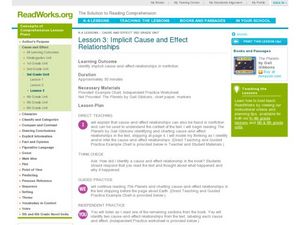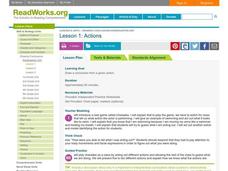Curated OER
Cliffhangers
Fourth graders identify the cliffhanger at the end of chapter 3 of Marvin and the Meanest Girl and predict what will happen next. In this cliffhanger lesson plan, 4th graders finish reading the book once they have made their predictions.
Curated OER
Historical Events
Fourth graders make predictions about the story Sweet Clara and the Freedom Quilt based on what they know about slavery. In this predictions lesson plan, 4th graders finish reading the story to see if they were right.
Curated OER
Chronological Order of Events in a Story with a Flashback
Fourth graders read the story Leaving Home and put the story events in chronological order. In this chronological order lesson plan, 4th graders use index cards and refer to the flashbacks in the story.
Curated OER
Lesson 1: Setting impact on the Plot
Fourth graders see how the setting affects the plot. In this setting activity, 4th graders listen to The Three Brothers : A German Folktale by Carolyn Croll and see how the setting affects the outcome of the story. They read a new story...
Curated OER
Identify Themes in Biographies
Fourth graders identify the theme based on the main events of the book A Picture Book of Anne Frank. In this themes worksheet, 4th graders discuss the themes of biographies and also read Sojourner Truth.
Curated OER
Choosing the Right Strategy
Fourth graders record words in their word journal that were difficult to decode from a magazine or newspaper article. In this words lesson plan, 4th graders also write down what strategy they used to decode it.
Read Works
Analyzing Author's Voice
Explore voice in poetry. Focus on several poems by Langston Hughes and identify words and phrases that represent the author's feelings about the topic of the poem. After working through a few poems together, individuals read "Youth" by...
Curated OER
Analyzing Relationships
Students explore relationships between story characters. In this story elements and reading comprehension lesson, students generate character traits of the characters in Bridge to Terabithia, by Katherine Paterson. Students describe...
Curated OER
Character and Relationship Changes
Fifth graders read a text and provide examples of why the characters in the book had a change in their relationship. In this character lesson plan, 5th graders write about the relationship in the beginning of the story and in the end of...
Read Works
Realistic Fiction
What makes a story seem real? Have your pupils record the realistic elements of the story Dogs Don't Tell Jokes in order to find out. They can focus elements of the characters, setting, and plot. Learners are asked to use textual...
Read Works
The Tone of a Poem
Tone and poetry are closely tied. Show your class how to determine the tone of a poem by noting your reactions and marking lines that bring out feelings. Next, work as a class to work through a second poem. Finally, have individuals read...
Curated OER
Analyzing Relationships
Fifth graders analyze the relationships among characters in a story. In this language arts lesson plan, 5th graders read Maniac Magee and discuss how the relationships between the characters change throughout the story.
Curated OER
Identifying Facts
Students evaluate what a fact is and what the characteristics of a fact are. In this fact and opinion lesson, students read through chapters in their books and point out facts that they find that cannot be disputed.
Curated OER
Historical Period
Students identify and describe ways in which life was different in the time historical period of Rosa Parks. In this historical time period lesson plan, students explain that one characteristic of a biography is that it takes place in a...
Curated OER
Lesson 2: Identifying an Author's Purpose (part 2)
Keep reinforcing the concept of author's purpose with a practice activity. After discussing the three purposes of writing, third graders will complete a graphic organizer intended to help them pin point textual evidence that proves...
Curated OER
Lesson 1:Cause and Effect Signal Words
Give your class a strategy they can use when trying to identify cause and effect relationships in text. You'll model, and they'll practice using signal words to quickly identify cause and effect. They focus on signal words such as, if,...
Curated OER
Implicit Cause and Effect Relationships
Cause and effect relationships can be found in both fiction and non-fiction texts. As they read the book, The Planets by Gail Gibbons, learners keep an eye out for cause and effect relationships. They chart all of the causes and effects...
Curated OER
Using Evidence to Describe a Character
It's all about the details found in the text, when children attempt to describe the main character from the story, Burnt Toast on Davenport Street. They first discuss the process by which one would go about using textual evidence and...
Curated OER
Realistic Fiction
Explore the characteristics of realistic fiction by reading and then analyzing the book, Allie’s Basketball Dream by Barbara E. Barber. Using the I do, we do, you do model, learners practice identifying realistic fiction based on how...
Curated OER
Main and Secondary Characters
Identify main and secondary characters from a fiction story. Kindergartners do a picture walk with the teacher, and then do the identifying on their own with another book. A good assignment for groups or a whole class to complete.
Curated OER
Actions
Students pair up and one of the students acts out an action while the other draws conclusions from their actions by drawing a picture of what they are doing. In this actions lesson plan, students play charades and guess what each other...
Curated OER
Pictures and Photographs
Students write the facts that they learned from the photographs in the book All About Cats and Kittens. In this pictures and photographs lesson plan, students present their fact to the class and add it to the chart.
Curated OER
Historical Fiction
Students discover how to identify historical fiction. In this historical fiction lesson, students read the story Meet Addy: An American Girl by Connie Porter. Students listen to the first chapter of the book read aloud. Students list...
Curated OER
Explicit Information versus Drawing Conclusions
Third graders identify explicit information and draw conclusions from text. In this instructional lesson, 3rd graders review models of each question type (explicit and conclusion) and practice reading a passage to answer questions.

























